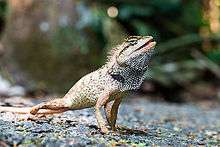Calotes emma
| Calotes emma | |
|---|---|
 | |
| Calotes emma alticristatus in Khao Yai National Park, Thailand | |
| Scientific classification | |
| Kingdom: | Animalia |
| Phylum: | Chordata |
| Subphylum: | Vertebrata |
| Class: | Reptilia |
| Order: | Squamata |
| Suborder: | Iguania |
| Family: | Agamidae |
| Subfamily: | Draconinae |
| Genus: | Calotes |
| Species: | C. emma |
| Binomial name | |
| Calotes emma J.E.Gray, 1845[1] | |
Emma Gray's forest lizard (Calotes emma) is an agamid lizard found in China, South Asia and Southeast Asia.
Etymology
The specific name, emma, is in honor of English conchologist Maria Emma Gray, the wife of John Edward Gray, the describer of this species.[2]
Morphology
Physical Structure: Three small groups of spines, completely separate from each other, on each side of the head—one behind the superciliary margin and two above each tympanum. Dorsal crest well developed on the neck and on the anterior part of the trunk, gradually disappearing behind. A transverse fold in front of each shoulder; gular sac but little developed. Tail compressed. About fifty-one series of scales round the middle of the trunk.
Color Pattern: Brownish olive, with brown bands across the back, which arc lighter in the middle and interrupted by a white band running along each side of the back; eyelids with short, radiating brown streaks; a brown band from behind the eye to above the tympanum; fold before the shoulder black, with an irregular white margin; legs and tail with indistinct dark cross bands.
Length: Maximum: 40 cm., Common: 28 cm. (Snout to vent 7.5 cm.).
Maximum published weight: ? g.
Distribution
Bangladesh (Satchari National Park), Cambodia, China (Guangdong, Yunnan), India (Assam), Laos, Malaysia (Peninsular), Myanmar, Thailand (including Phuket) & Vietnam (including Pulo Condore Islands) and Possibly in Bhutan.
An inhabitant of Mergui, whence have received it from Professor Oldham, ranging northwards perhaps to the Khasya Hills; extremely doubtful as an inhabitant of Afghanistan. Mr. Blyth mentions it amongst a collection made by Captain Bedmore at Schwe Gyen on the Sitang River in Pegu.
Vernacular names
Bengali: কেশর গিরিগিটি, ঝুঁটি গিরিগিটি, ঝুঁটি রক্তচোষা, যুথিয়াল গিরিগিটি (Juthial girigiti),
Bhutanese: ?
Burmese: ?
Chinese: ?
English: Crested forest lizard, Emma Gray’s crested forest lizard, Emma Gray's forest lizard and Spiny-headed forest lizard.
Hindi & Assamese: ?
Khmer (Cambodian): ?
Laotian: ?
Malay: ?
Thai: ?
Vietnamese: ?
Habitat
Terrestrial and arboreal; diurnal; inhabits various forest habitats including dry deciduous, coastal, and moist evergreen.
Diet
Insectivorous;[3] feeds on termites, grasshoppers, ants, cockroaches, beetles, diverse species of moths and low flying butterflies and soil-living insects and their larvae.[4]
Reproduction
Oviparous; female lays 10-12 eggs in May–June; incubation period about 60–70 days.
Human uses
Used in pet trade. Play rolls in echo-system by eating various types of insects and otherwise.
Threat to humans
Non-venomous and completely harmless to humans.
IUCN threat status
Not evaluated (NE).
Subspecies
References
- ↑ Gray JE. (1845). Catalogue of the Specimens of Lizards in the Collection of the British Museum. London: Trustees of the British Museum. (Edward Newman, printer). xxvii + 289 pp.
- ↑ Beolens B, Watkins M, Grayson M. (2011). The Eponym Dictionary of Reptiles. Baltimore: Johns Hopkins University Press. xiii + 296 pp. ISBN 978-1-4214-0135-5. (Calotes emma, p. 83).
- ↑ http://faunaofindia.nic.in/PDFVolumes/hpg/007/index.pdf
- ↑ http://www.researchgate.net/publication/271795923_p_Calotes_emma_Gray_1845_%28Squamata_Agamidae%29_range_extension_and_new_addition_to_the_reptilian_fauna_of_Tripura_northeast_Indiap
- 1 2 Calotes emma at the Reptarium.cz Reptile Database. Accessed 9 December 2014.